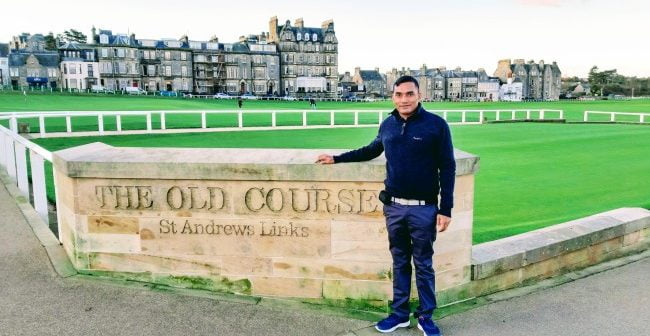Bhupendra Singh, the Golf Course Superintendent at Glade One Golf Resort in Ahemdabad, Gujarat recently made a trip to St. Andrews, the home of golf after securing a top-rank at the National Golf Rules of IGU-R&A, which promoted him for a trip to Scotland for R&A certification of Golf Rules Refereeing.
Here, Mr Singh shares his story from a week’s visit in February 2020, when the world was still running normal.

Golf Course Superintendent
Glade One Golf Resort
In present Covid World, it is not hard to understand the worth of home for anybody. It is not only a resort for emotional healing but also a reflection of our roots. ‘Home’ is a special place!
When we meet someone, or make a new acquaintance we often ask, where do you come from? A place of origin somehow defines the character of an individual or an enterprise, and in turn itself gets redefined by it. This is absolutely valid for the game of golf that originated on the Scottish sea side sands of St. Andrews more than six centuries ago and since then has been steadily gripping the athletic spirit of the world.
I was enchanted by the game and its charm more than a decade ago, and since then I had been on a continued pursuit of understanding the game, its tangible and intangible aspects. My quest for the game had often taken me to different parts of the world, but my last visit in pre-Covid world was to the home of golf. Everything passes, so the Covid pandemic too will pass and golfers will tour the world again. For the benefit of golf smitten souls who are awaiting the ports to open I am sharing my experience of visit in this piece.
Professionally on occasions I posture as a ‘golf rules referee’, but I identify myself more as a Green Keeper. However it is my tilt towards the rules of golf that eventually secured me an invite from the holy land of golf, and occasioned my visit to learn the ‘Rules of Golf’ better from those who actually are custodian of the code at R&A.
I wished to travel the tracks followed by the champions of the game, but more so the tracks tended by the foremost pioneer of my ‘green keeping profession’ the Old Tom Morris. I wanted to be there at the cradle of golf, but more so I wanted to be at the first laboratory of green keeping trade where the ‘Grand Old Man’ sprinkled sands on grass from his wheel barrow and formulated the ‘first mixes’ of green keeping.
I wanted to see the slick surfaces that treacherously makes and breaks champions of the sport, but more so I wanted to pay my obeisance to the toil of the ‘Grandmaster of Green Keeping’ who defined the game, its character and its prospects!
For first timers it is certainly a ‘goose bumps’ experience, where you are so overwhelmed that it is hard to contain the eternal child within. A part of you holds you to behave like a grown up but the other coerce you to be childishly puerile. There is something special about the home; it is special for all of us probably because when we are at home, we are what we are!
But whether you are from the ‘House of Lords or Commons’ the warmth of welcome is in equity at the ‘Home of Golf’! I am sharing the story of my golfing expedition, in this piece of experience of my visit to the venerable address; The Old Course, St. Andrews.
St. Andrews; the golfing town is named after a namesake patron saint of this tiny stretch of seaside settlement. This quaint little town is probably a 30 minute walk wide, still its prominence is unfathomable. It turned into a seat of pilgrimage in Middle Ages, as the relics of St. Andrews were believed to have been housed in a great cathedral of St. Andrews, of which only ruins remain today. In the tail end of Middle Ages its significance as a golfing pilgrimage began to burgeon with more and more souls falling for love of the game.
Initially ‘the men of God and the men of King’ were weary of the surge of this bewitching force popularly known as golf amongst its subjects, which made them flout even Sunday Sabbath and skip archery sessions for a round of golf. However in 1502 golf got its Royal Seal and support from King James IV who himself got engrossed by it and turned a golfer himself. Thereafter Archbishop John Hamilton probably perceived the will of god when he let the ‘west sands’ links to serve as a cradle for the game during its infancy and allowed towns people to play golf on the links in 1552.
The Links of St. Andrews; West Sands have several courses but the shrine for a golfer is ‘The Old Course’. It is not only the oldest and revered golf track in the world but is also considered best in many ways. When you walk the Old Course you actually tread on a canvas coloured with layers of history of the game, for an old golfer of the links can relate you an anecdote, tell a tale or sometimes a legend for every step you walk.
Large double greens are one of its uniqueness and ingenious invention of Old Tom Morris, the first golf architect and the keeper of the greens. Seven greens are shared by two holes each. Each hole has its unique name. The seven hundred year old Swilcan Bridge originally used by shepherds of the links for crossing Swilcan Burn, spanning the first and eighteenth holes is the one bridge in golf that every golfer wish to cross in his life time. For a modern visitor a click at the Swilcan Bridge is an attestation of a visit paid, which every visitor wants to socially tweet and treasure personally.
The Old Course has 112 bunkers most with their own name and has their own lore and legends. The ‘Hell Bunker’ on the 14th hole and the ‘Road Bunker’ on the 17th hole are the most familiar ones but there are many innocuous pits perched behind the mounds or around the greens which had wreaked death to the scorecards of many professional golfers in silence.
Gorse on the grounds and wild winds overhead are other elements to be negotiated while driving a ball and yourself through these rough, heathery links. Fickleness of weather, blustery winds and treacherous traps can choke even the champions.
Bobby Jones when he first played St Andrews in the 1921 Open Championship had landed into a bunker on the 11th hole during 3rd round. He lost his nerves when he could not get out after he took four swings. Eventually he did not turn in his score card, disqualifying himself. Six years later, the Open Championship and Bobby returned to St Andrews. This time he conquered the course and was crowned Champion. Later in 1958 the town of St Andrews gave Jones the ‘key to the city’; other than Benjamin Franklin, he is the only American to receive the honour.
The Open Championship is not only an oldest test of golf, but also is a testament for champions of the game. But whether you pitch or putt, you will have to cross over the ‘valley of sin’ to be crowned as champion of the Open, at the 18th hole.
The Links Trust of St. Andrews; is trusted with the responsibility of managing the ‘Old Course’ along with six other public golf courses; the Balgove, Eden, Jubilee, Strathtyrum, New Course and Castle Course.
While buying souvenir merchandise from ‘The Old Course Shop’, a lady at the counter told me that it is managed by St. Andrews Links Trust along with three other shops and additional facilities including a golf academy and three clubhouses.
St Andrews Links Trust is a charitable organization which spends back it’s surpluses into the organisation and in maintaining the world famous public courses open for all in a sustainable manner, here at the Home of Golf. St Andrews Links Trust employs around 400 people in the peak season, boasting itself as one of the largest employers in the town.
The Royal and Ancient Golf Club of St Andrews; it was 14th May 1754, when twenty two “noblemen and gentlemen” came together to form the ‘Society of St. Andrews Golfers’, which is now known as The Royal and Ancient Golf Club. It is the most influential and coveted Clubs in the golfing world.
The iconic sand stone building behind the first tee of Old Course; is the members only Club House of The Royal and Ancient Golf Club. This too is lore-laden, with history hung on its walls in the form of old layout maps of ancient course or in the form of first ever trophies of the sport shelved in its glass-wooden cases. However before the members could find this halting hole of 19th ,for about 100 years they had wandered from tavern to tavern of St. Andrews for their gatherings and meetings.
The present Club House is a work of several architects and up gradations over years. This place is all grace with its basic crisp block-shaped design but certainly it has an extraordinary air of exclusivity.It was too much for me to have dreamt an access through these doors! However sometimes it’s not only about one’s worldly fortune that can guarantee an access in such premises but rather sheer luck can make you fortunate, and avail you a pass through such entrances.
Golf is a game of possibilities and during this trip I got fortunate to have a ‘table tent’ of my name on a dinner table in the dining hall of this majestic house of golf .To further add to the adventure I was joined by an R&A member himself, who not only assumed the role of a host for our table there but also quenched our queries about the golfing traditions of the house by passing a goblet of wine along with his personal insights. It was a great company and an evening with the brightest shades of dusk!
The R&A; it came to existence in 2004 and derives its name from the members’ golf club The Royal and Ancient Golf Club of St Andrews. The R&A works for the good of the game by engaging in activities undertaken for the benefit and promotion of the sport of golf.
R&A operates as a virtuous circle by staging world class championships, reinvesting in the game, governing the rules and modernising the sport. It works for the future of game by making it accessible, appealing and inclusive.
It organises The Open, golf’s oldest and Major championship along with a series of amateur and junior golf events, as well as international matches including the Walker Cup, the St Andrews Trophy and the Jacques Leglise Trophy etc.
R&A’s ‘Working for Golf programme’, emphasizes junior golf. It also promotes the progression of the sport in emerging golfing nations, by supporting coaching, provision of more public golf courses and improved practice facilities.
The R&A governs the sport of golf worldwide together with USGA, operating in separate jurisdictions while sharing a commitment to a single code for the Rules of Golf, Rules of Amateur Status and Equipment Standards. Its affiliates are 156 organisations across the world from amateur and professional golf including our own Indian Golf Union. It stands tall as a custodian of golf on behalf of over 30 million golfers in 143 countries.
Through its Equipment Standard division, state-of-the-art testing facility and a team of scientists it ensures that every new club and ball manufactured and used in the game conform so as to preserve the parity in golf. The R&A also seek and strive to help the game grow throughout the world in a commercially and environmentally sustainable manner.
Along with all this ‘Tournament Administrators and Referees Seminar’ spanning four days of intensive golf rules teaching and a highest level of Golf Rules certification is also R&A’s flagship programme. In an interaction with the team R&A during this year’s seminar I found them to be some of the finest, dedicated professionals and passionate people working for the good of the game.
Golf is glorious and equally cryptic in character; even the cover page of the Rule book of golf has an unknown ‘Silhouette Golfers’. As in life so in golf, sometimes it is difficult to make out anything out of such mysterious shades around us. But by sheer serendipity in the seminar, I even got to meet Victoria, the ‘Silhouette girl of golf’. Did I mention, ‘golf is a game of possibilities’? Of course like life!



